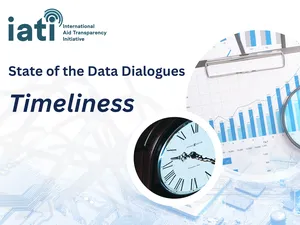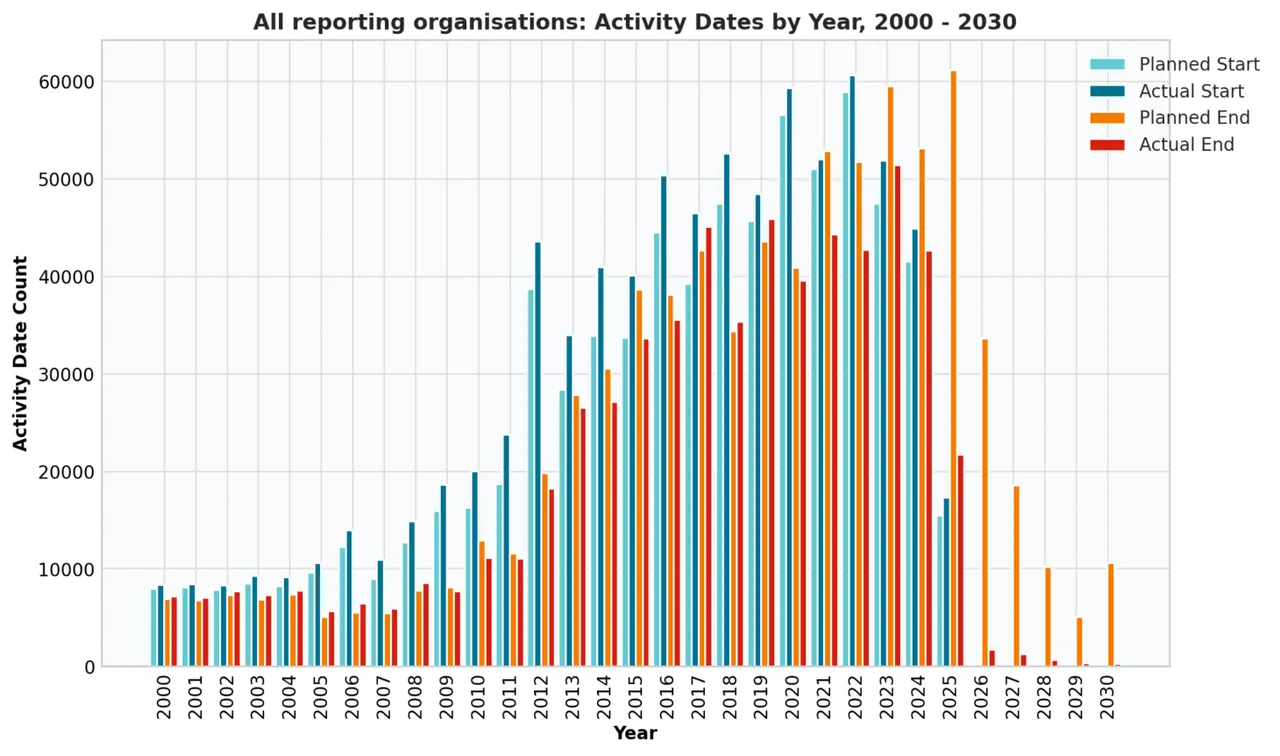Interactive Analysis: Nearly 900,000 Activities Reveal the Need for Timely Data
The IATI Secretariat is pleased to share the latest State of the Data interactive analysis: Timeliness – Why Timely Data Matters.
This new analysis takes an in-depth look at how current IATI data really is. It examines how often organisations update their information, how quickly data reflects real-world activity, and what this means for decision-making across development and humanitarian communities.

For the first time, you can explore IATI’s timeliness indicators interactively, viewing both frequency (how often data is updated) and time lag (how up-to-date it is) across the IATI publisher network.
Explore Interactive Analysis: State of the data - Timeliness
What the analysis shows
Publishing data through IATI allows organisations to share not only historical data but also their current and planned activities. This flexibility means IATI data can provide a uniquely real-time, forward-looking picture of global development — while also preserving a valuable record of completed work that continues to inform learning and accountability.
This analysis investigates:
- How timeliness is measured in IATI, including frequency and time lag data from the IATI Dashboard over the past decade.
- What timely data looks like in practice – through IATI Standard data fields, including elements like activity dates, transactions, and the last-updated-datetime attribute.
- What publishing patterns reveal – across the entire IATI dataset, and by organisation type.
Over the years, it has also surfaced key insights from analysis of IATI data, showing how a small number of large publishers contribute the majority of activity updates, and how the frequency of publication can vary significantly between organisations.
At a glance:
- 884,074 unique activities analysed across 1,754 reporting organisations.
- 10% of publishers are responsible for over 80% of all IATI data, underlining the importance of improving regular updates across the wider community.
- 12 organisations provide updates to their data weekly, which represent 11% of the total of activities within IATI data.
- To provide a fuller picture of how IATI data evolves over time, the analysis also examines other date elements in the IATI Standard, including more than 2.9 million activity dates showing planned and actual start and end points, as well as financial dates that span multiple years of transactions and budget periods.

These findings highlight both the strength of IATI data as a living system that can be updated at any time— and the areas for improvement as we continue to strengthen the timeliness and reliability of aid information.
Why timely data matters
In an era of fast-changing global needs, timely development and humanitarian data is essential.
Having access to up-to-date IATI data enables a wide range of actors to make informed, evidence-based decisions:
- Governments can use IATI data to track incoming aid flows in real-time and guide national budgeting and planning.
- Humanitarian responders can rely on timely information to map active partners and available resources during crises.
- Donors and multilateral agencies can use IATI data to monitor disbursement rates and ensure resources reach the right partners on schedule.
- Researchers and journalists can use it to identify early trends and hold the system accountable quickly and effectively.
IATI’s open data framework allows publishers to update information as soon as it changes — a crucial advantage over traditional annual reporting systems. This new analysis shows that, when updated frequently and consistently, IATI data can fill key information gaps across the aid ecosystem.
When data is delayed, it limits informed decisions. When data is timely, it enables effective development and humanitarian cooperation, transparency, and accountability.
Join the State of the Data Dialogues
The release of this analysis is designed to start a conversation. The IATI Secretariat invites you to join the dialogues to explore how we can strengthen data timeliness and publishing practices together.
During the sessions, the Secretariat will explain how the analysis was approached, including:
- What can tools like the IATI Dashboard and IATI Validator reveal to us?
- What are the common publishing practices that help us understand which IATI activities are current?
- What further information can we learn about the timeliness of IATI data?
The webinar will also explore what drives organisations to publish timely data and which levers could encourage more frequent, reliable updates.
Event Details:
- Webinar 1: Monday 17 November 2025, 10–11 am EST / 3–4 pm UTC
- Location: Online (Zoom)
Recognising the value of IATI data
Although this analysis and the related dialogues focus on timely data, it is important to recognise the value of all IATI data when it is well-maintained and timely updated. Many organisations continue to publish and update information on activities throughout their entire lifecycle, including those that have been completed or closed, in some cases dating back nearly 15 years.
This long-term record strengthens accountability and learning. It allows researchers, partners, and policymakers to trace funding trends, assess long-term results, and understand how priorities and partnerships have evolved.
While the focus here is on timeliness, looking at how often publishers update their data and what these updates reveal about current activities helps strengthen IATI’s collective understanding of data quality and the continued relevance of published information, which is also essential to providing a complete view of international cooperation over time.
Looking ahead
This analysis marks the beginning of a broader effort to understand and enhance the timeliness of global aid data.
As IATI enters its new Strategic Plan 2026–2030, insights from this work will inform future steps to strengthen data quality, frequency, and usability — ensuring that timely, transparent information remains at the heart of effective development cooperation.
We encourage you to explore the interactive analysis, share it with colleagues, and bring your ideas to the State of the Data Dialogues.